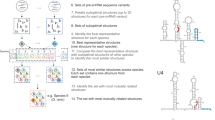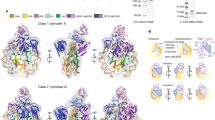Abstract
Most histone precursor mRNAs (pre-mRNAs) in metazoans are matured by 3′-end cleavage directed by the U7 small nuclear ribonucleoprotein (snRNP). RNA functional groups necessary for in vivo assembly and activity of the U7 snRNP were examined by nucleotide-analog interference mapping and mutagenesis using a chimeric mouse histone H4 pre-mRNA–U7 snRNA construct that is cleaved in cis in Xenopus laevis oocytes. Assembly of the unique U7 Sm protein core is rate limiting for processing in vivo and requires four conserved nucleotides within the U7 Sm-binding site, as well as the correct positioning and size of the U7 terminal stem-loop structure. To our surprise, pseudouridine substitution revealed a requirement for backbone flexibility at a particular position within the U7 Sm site, providing in vivo biochemical evidence that an unusual C2′-endo sugar conformation is necessary for assembly of the Sm ring.
This is a preview of subscription content, access via your institution
Access options
Subscribe to this journal
Receive 12 print issues and online access
$189.00 per year
only $15.75 per issue
Buy this article
- Purchase on Springer Link
- Instant access to full article PDF
Prices may be subject to local taxes which are calculated during checkout





Similar content being viewed by others
References
Strub, K., Galli, G., Busslinger, M. & Birnstiel, M.L. The cDNA sequences of the sea urchin U7 small nuclear RNA suggest specific contacts between histone mRNA precursor and U7 RNA during RNA processing. EMBO J. 3, 2801–2807 (1984).
Mowry, K.L. & Steitz, J.A. Identification of the human U7 snRNP as one of several factors involved in the 3′ end maturation of histone premessenger RNA's. Science 238, 1682–1687 (1987).
Dominski, Z., Yang, X.C., Purdy, M. & Marzluff, W.F. Cloning and characterization of the Drosophila U7 small nuclear RNA. Proc. Natl. Acad. Sci. USA 100, 9422–9427 (2003).
Pillai, R.S. et al. Unique Sm core structure of U7 snRNPs: assembly by a specialized SMN complex and the role of a new component, Lsm11, in histone RNA processing. Genes Dev. 17, 2321–2333 (2003).
Schümperli, D. & Pillai, R.S. The special Sm core structure of the U7 snRNP: far-reaching significance of a small nuclear ribonucleoprotein. Cell. Mol. Life Sci. 61, 2560–2570 (2004).
Azzouz, T.N. et al. Toward an assembly line for U7 snRNPs: interactions of U7-specific Lsm proteins with PRMT5 and SMN complexes. J. Biol. Chem. 280, 34435–34440 (2005).
Stefanovic, B., Hackl, W., Lührmann, R. & Schümperli, D. Assembly, nuclear import and function of U7 snRNPs studied by microinjection of synthetic U7 RNA into Xenopus oocytes. Nucleic Acids Res. 23, 3141–3151 (1995).
Pillai, R.S., Will, C.L., Lührmann, R., Schümperli, D. & Müller, B. Purified U7 snRNPs lack the Sm proteins D1 and D2 but contain Lsm10, a new 14 kDa Sm D1-like protein. EMBO J. 20, 5470–5479 (2001).
Grimm, C., Stefanovic, B. & Schümperli, D. The low abundance of U7 snRNA is partly determined by its Sm binding site. EMBO J. 12, 1229–1238 (1993).
Wu, C.H., Murphy, C. & Gall, J.G. The Sm binding site targets U7 snRNA to coiled bodies (spheres) of amphibian oocytes. RNA 2, 811–823 (1996).
Marzluff, W.F. & Duronio, R.J. Histone mRNA expression: multiple levels of cell cycle regulation and important developmental consequences. Curr. Opin. Cell Biol. 14, 692–699 (2002).
Schaufele, F., Gilmartin, G.M., Bannwarth, W. & Birnstiel, M.L. Compensatory mutations suggest that base-pairing with a small nuclear RNA is required to form the 3′ end of H3 messenger RNA. Nature 323, 777–781 (1986).
Bond, U.M., Yario, T.A. & Steitz, J.A. Multiple processing-defective mutations in a mammalian histone pre-mRNA are suppressed by compensatory changes in U7 RNA both in vivo and in vitro. Genes Dev. 5, 1709–1722 (1991).
Dominski, Z., Zheng, L.X., Sanchez, R. & Marzluff, W.F. Stem-loop binding protein facilitates 3′-end formation by stabilizing U7 snRNP binding to histone pre-mRNA. Mol. Cell. Biol. 19, 3561–3570 (1999).
Kolev, N.G. & Steitz, J.A. Symplekin and multiple other polyadenylation factors participate in 3′-end maturation of histone mRNAs. Genes Dev. 19, 2583–2592 (2005).
Dominski, Z., Yang, X.C. & Marzluff, W.F. The polyadenylation factor CPSF-73 is involved in histone-pre-mRNA processing. Cell 123, 37–48 (2005).
Stefanovic, B., Wittop Koning, T.H. & Schümperli, D. A synthetic histone pre-mRNA-U7 small nuclear RNA chimera undergoing cis cleavage in the cytoplasm of Xenopus oocytes. Nucleic Acids Res. 23, 3152–3160 (1995).
Ryder, S.P. & Strobel, S.A. Nucleotide analog interference mapping. Methods 18, 38–50 (1999).
Ryder, S.P., Ortoleva-Donnelly, L., Kosek, A.B. & Strobel, S.A. Chemical probing of RNA by nucleotide analog interference mapping. Methods Enzymol. 317, 92–109 (2000).
Szewczak, L.B., DeGregorio, S.J., Strobel, S.A. & Steitz, J.A. Exclusive interaction of the 15.5 kD protein with the terminal box C/D motif of a methylation guide snoRNP. Chem. Biol. 9, 1095–1107 (2002).
Lerner, E.A., Lerner, M.R., Janeway, C.A., Jr. & Steitz, J.A. Monoclonal antibodies to nucleic acid-containing cellular constituents: probes for molecular biology and autoimmune disease. Proc. Natl. Acad. Sci. USA 78, 2737–2741 (1981).
Fischer, U., Sumpter, V., Sekine, M., Satoh, T. & Lührmann, R. Nucleo-cytoplasmic transport of U snRNPs: definition of a nuclear location signal in the Sm core domain that binds a transport receptor independently of the m3G cap. EMBO J. 12, 573–583 (1993).
Gilmartin, G.M., Schaufele, F., Schaffner, G. & Birnstiel, M.L. Functional analysis of the sea urchin U7 small nuclear RNA. Mol. Cell. Biol. 8, 1076–1084 (1988).
Arnez, J.G. & Steitz, T.A. Crystal structure of unmodified tRNA(Gln) complexed with glutaminyl-tRNA synthetase and ATP suggests a possible role for pseudo-uridines in stabilization of RNA structure. Biochemistry 33, 7560–7567 (1994).
Newby, M.I. & Greenbaum, N.L. Investigation of Overhauser effects between pseudouridine and water protons in RNA helices. Proc. Natl. Acad. Sci. USA 99, 12697–12702 (2002).
Charette, M. & Gray, M.W. Pseudouridine in RNA: what, where, how, and why. IUBMB Life 49, 341–351 (2000).
Davis, D.R. Stabilization of RNA stacking by pseudouridine. Nucleic Acids Res. 23, 5020–5026 (1995).
Uesugi, S., Miki, H., Ikehara, M., Iwahashi, H. & Kyogoku, Y. A linear relationship between electronegativity of 2′-substituents and conformation of adenine nucleosides. Tetrahedr. Lett. 20, 4073–4076 (1979).
Altona, C. & Sundaralingam, M. Conformational analysis of the sugar ring in nucleosides and nucleotides. Improved method for the interpretation of proton magnetic resonance coupling constants. J. Am. Chem. Soc. 95, 2333–2344 (1973).
Streit, A., Koning, T.W., Soldati, D., Melin, L. & Schümperli, D. Variable effects of the conserved RNA hairpin element upon 3′ end processing of histone pre-mRNA in vitro. Nucleic Acids Res. 21, 1569–1575 (1993).
Jones, M.H. & Guthrie, C. Unexpected flexibility in an evolutionarily conserved protein-RNA interaction: genetic analysis of the Sm binding site. EMBO J. 9, 2555–2561 (1990).
McConnell, T.S., Lokken, R.P. & Steitz, J.A. Assembly of the U1 snRNP involves interactions with the backbone of the terminal stem of U1 snRNA. RNA 9, 193–201 (2003).
Golembe, T.J., Yong, J. & Dreyfuss, G. Specific sequence features, recognized by the SMN complex, identify snRNAs and determine their fate as snRNPs. Mol. Cell. Biol. 25, 10989–11004 (2005).
Jarmolowski, A. & Mattaj, I.W. The determinants for Sm protein binding to Xenopus U1 and U5 snRNAs are complex and non-identical. EMBO J. 12, 223–232 (1993).
Hartmuth, K., Raker, V.A., Huber, J., Branlant, C. & Lührmann, R. An unusual chemical reactivity of Sm site adenosines strongly correlates with proper assembly of core U snRNP particles. J. Mol. Biol. 285, 133–147 (1999).
Raker, V.A., Hartmuth, K., Kastner, B. & Lührmann, R. Spliceosomal U snRNP core assembly: Sm proteins assemble onto an Sm site RNA nonanucleotide in a specific and thermodynamically stable manner. Mol. Cell. Biol. 19, 6554–6565 (1999).
Urlaub, H., Raker, V.A., Kostka, S. & Lührmann, R. Sm protein-Sm site RNA interactions within the inner ring of the spliceosomal snRNP core structure. EMBO J. 20, 187–196 (2001).
Törö, I. et al. RNA binding in an Sm core domain: X-ray structure and functional analysis of an archaeal Sm protein complex. EMBO J. 20, 2293–2303 (2001).
Thore, S., Mayer, C., Sauter, C., Weeks, S. & Suck, D. Crystal structures of the Pyrococcus abyssi Sm core and its complex with RNA. Common features of RNA binding in archaea and eukarya. J. Biol. Chem. 278, 1239–1247 (2003).
Schumacher, M.A., Pearson, R.F., Møller, T., Valentin-Hansen, P. & Brennan, R.G. Structures of the pleiotropic translational regulator Hfq and an Hfq-RNA complex: a bacterial Sm-like protein. EMBO J. 21, 3546–3556 (2002).
Inners, L.D. & Felsenfeld, G. Conformation of polyribouridylic acid in solution. J. Mol. Biol. 50, 373–389 (1970).
Newby, M.I. & Greenbaum, N.L. Sculpting of the spliceosomal branch site recognition motif by a conserved pseudouridine. Nat. Struct. Biol. 9, 958–965 (2002).
Cotten, M., Gick, O., Vasserot, A., Schaffner, G. & Birnstiel, M.L. Specific contacts between mammalian U7 snRNA and histone precursor RNA are indispensable for the in vitro 3′ RNA processing reaction. EMBO J. 7, 801–808 (1988).
Acknowledgements
We thank S. Strobel (Yale University) for generous gifts of 5′-O-(1-thio)-nucleoside analog triphosphates; R. Breaker, K. Tycowski and L. Weinstein-Szewczak for stimulating discussions; T. Steitz, K. Tycowski, S. Vasudevan and A. Alexandrov for critical reading of the manuscript; and A. Miccinello for secretarial help. This work was supported by US National Institutes of Health grant GM26154 to J.A.S. J.A.S. is an investigator of the Howard Hughes Medical Institute.
Author information
Authors and Affiliations
Corresponding author
Ethics declarations
Competing interests
The authors declare no competing financial interests.
Supplementary information
Supplementary Fig. 1
Known and putative U7 snRNAs identified by BLAST search (PDF 29 kb)
Supplementary Fig. 2
Three-dimensional model of the hydrogen bond–mediated water bridge formed by Ψ in RNA (PDF 44 kb)
Rights and permissions
About this article
Cite this article
Kolev, N., Steitz, J. In vivo assembly of functional U7 snRNP requires RNA backbone flexibility within the Sm-binding site. Nat Struct Mol Biol 13, 347–353 (2006). https://doi.org/10.1038/nsmb1075
Received:
Accepted:
Published:
Issue Date:
DOI: https://doi.org/10.1038/nsmb1075
This article is cited by
-
Mutations in RNU7-1 Weaken Secondary RNA Structure, Induce MCP-1 and CXCL10 in CSF, and Result in Aicardi-Goutières Syndrome with Severe End-Organ Involvement
Journal of Clinical Immunology (2022)
-
cGAS-mediated induction of type I interferon due to inborn errors of histone pre-mRNA processing
Nature Genetics (2020)
-
U2 snRNA is inducibly pseudouridylated at novel sites by Pus7p and snR81 RNP
The EMBO Journal (2011)
-
Functional organization of the Sm core in the crystal structure of human U1 snRNP
The EMBO Journal (2010)



